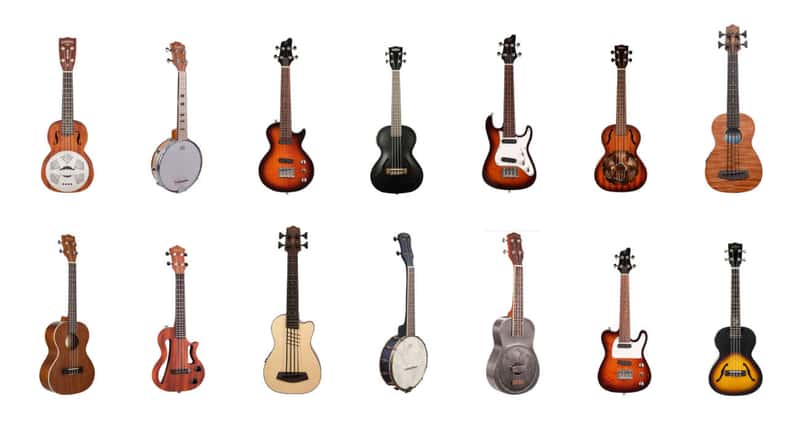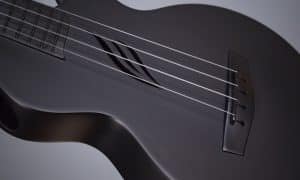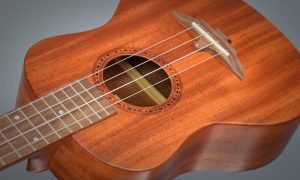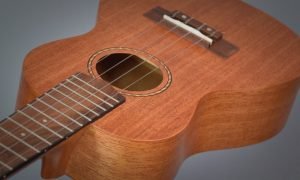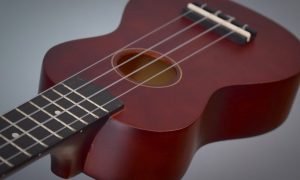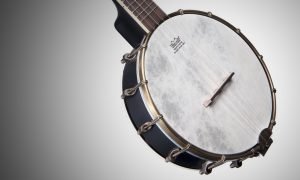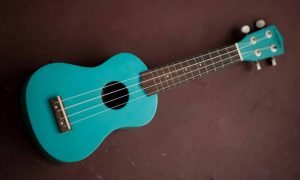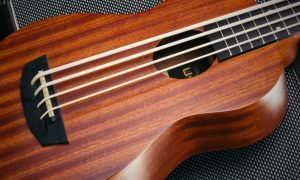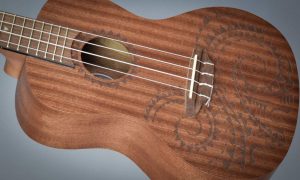What are the different types of ukuleles?
Most people are familiar with the traditional wooden acoustic ukulele, but there are many other interesting ukulele styles. This article will provide a brief overview of many of the different types of ukuleles.
[adinserter block=”8″]
Types of Ukuleles Vs. Ukulele Sizes
Many people searching “types of ukuleles” are actually interested in ukulele sizes. This article is about the different types/styles of ukulele and not the various sizes.
I’ll cover sizes briefly here, but for a more complete guide check out my article on ukulele sizes.
[adinserter block=”8″]
Quick Picks
In a rush? Don’t want to do a ton of research? Here are three of the best beginner ukuleles I’ve found for sale online for under $100.
These are all concert or tenor ukuleles, which are my favorite ukulele sizes and what I recommend for most beginners.
I’ve purchased and played each of these models, so I feel confident recommending them for any beginning ukulele player. To learn more, check out my ukulele review section.
|
|
Lohanu LU-C Tenor | 7,809 Reviews | $79.97 | Check Current Price |
|
|
Kala KA-15S Concert | 4,286 Reviews | $99.00 | Check Current Price |
|
|
Donner DUC-1 Concert | 8,713 Reviews | $55.99 | Check Current Price |
Standard Ukulele Sizes
Ukuleles come in four primary sizes. From smallest to largest, they are soprano, concert, tenor, and baritone.
Soprano, concert, and tenor ukes are all tuned the same way: G-C-E-A. This is known as standard tuning.
The shared tuning of these three sizes means that if you learn to play on a soprano ukulele, you will also be able to play a concert or tenor.
All other things being equal, a larger size will have more volume and bass than its smaller counterpart. This is why many players gravitate to concert and tenor ukuleles.
The larger ukes also have a longer fretboard, which can make them a bit easier to play for some people.
Baritone Ukulele
Baritone ukuleles are the largest size have a different, lower-pitched tuning: D-G-B-E. This is exactly like the four highest-pitched strings of a guitar.
While this tuning has some similarities to the other sizes, the baritone is still in its own category.
Baritone ukuleles have the largest body of the four primary sizes, and their lower tuning gives them a lot of warmth and resonance.
Baritone ukuleles are a lot of fun, but their non-standard tuning means they may not be an ideal choice for first-time uke players.
Looking for a baritone ukulele? Check out my reviews of the best baritone ukuleles.
[adinserter block=”8″]
Banjo Ukulele (Banjolele)
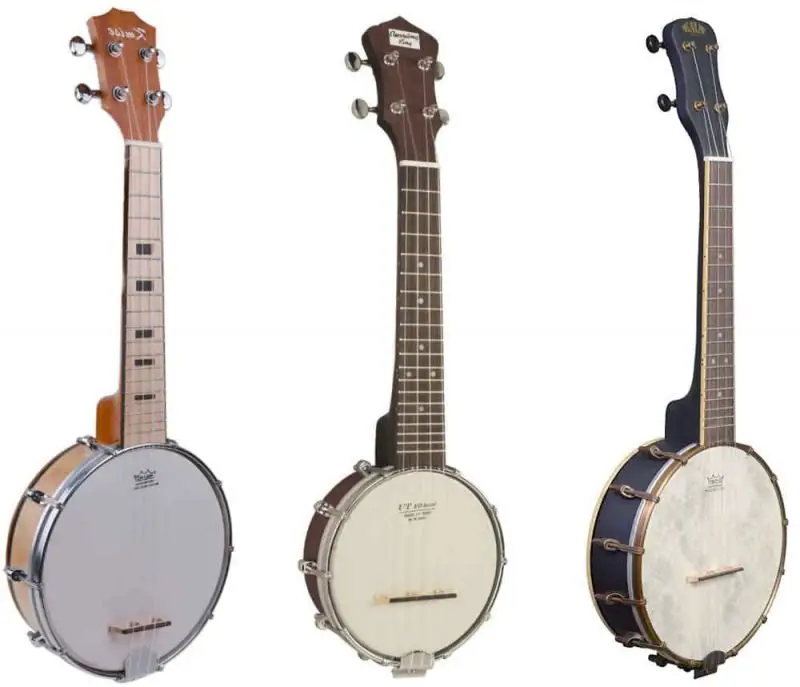
A banjo ukulele has four strings and is tuned exactly like a standard ukulele, but it has the body of a banjo. They’re commonly called banjoleles and are one of the most popular “non-standard” types of ukuleles.
Banjo ukes usually have nylon strings like a standard ukulele and are strummed or fingerpicked just any other uke. You can play standard ukulele music on a banjolele, but music written for banjo will not work with a banjo ukulele.
Banjo ukuleles are much brighter and louder than regular ukes. They also have less sustain, which means that the notes die out quicker and have a more “plunky” quality.
Banjoleles also lack the warm, rich, harp-like tone of a standard ukulele. The staccato tone of a banjo ukulele makes it useful for certain rhythm and strumming situations, but may not work as well with more modern styles of music.
Some people would describe the tone of a banjo uke as “punchy” or “crisp” while others might say “harsh” or “tinny.” There are lots of great YouTube videos of banjo ukes, so check them out and decide for yourself!
The basic design of the banjo ukulele dates back to the 1920s. There are a number of companies building new banjo ukes today, but many people like to buy vintage banjo ukes on eBay.
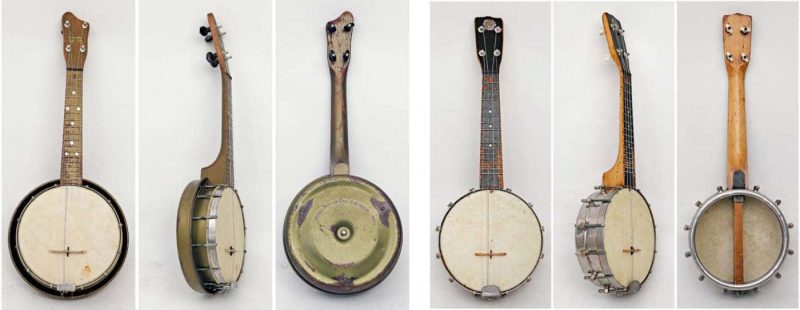
Recommended Banjo Ukuleles
If you’re just looking to experiment with the banjolele, a beginner model like the ones made by Kmise or Oscar Schmidt would be fine.
Players seeking something a little nicer should check out the banjo ukes from companies like Deering or Magic Fluke.
[adinserter block=”8″]
Guitalele (Guitar Ukulele)
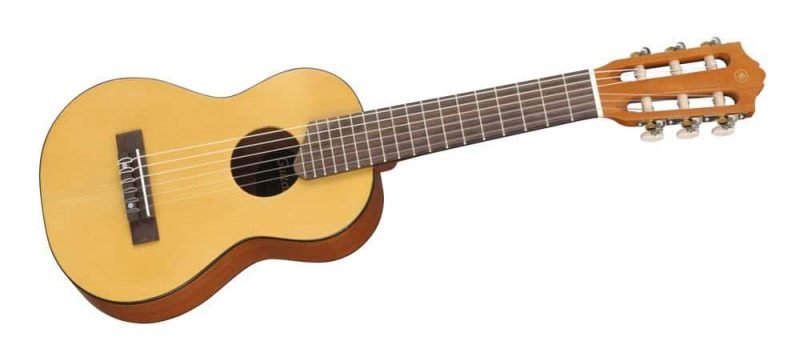
A guitalele is a six-string ukulele. Most guitaleles have a baritone ukulele body size, which is the largest of the four primary ukuleles sizes. Guitaleles are also known as guitar ukuleles and (less commonly) guileles.
A guitalele is tuned just like a guitar but five half steps higher in pitch. It’s the same as playing a guitar with a capo on the fifth fret. If you can play guitar then you’ll be able to play a guitalele; everything will just be pitched up.
Another way to look at the tuning of a guitalele is that it’s just like a standard ukulele with an additional two bass strings. A standard uke tuning is G-C-E-A and a guitalele’s tuning is A-D-G-C-E-A.
The guitar ukulele is usually strung with nylon strings similar to what you’ll find on a ukulele or classical guitar. These strings are much softer and easier to play than the steel strings of a standard acoustic guitar.
The tone of a guitalele falls somewhere between a standard ukulele and a nylon string guitar, making the instrument popular with guitarists and uke players alike. Plus, the compact size is perfect for children or travel.
Recommended Guitaleles
The Yamaha GL1 shown at the beginning of this article is probably the most popular guitar uke on the market. It’s available in the standard natural finish pictured above, as well as sunburst and “Persimmon Brown.”
Bass Ukulele
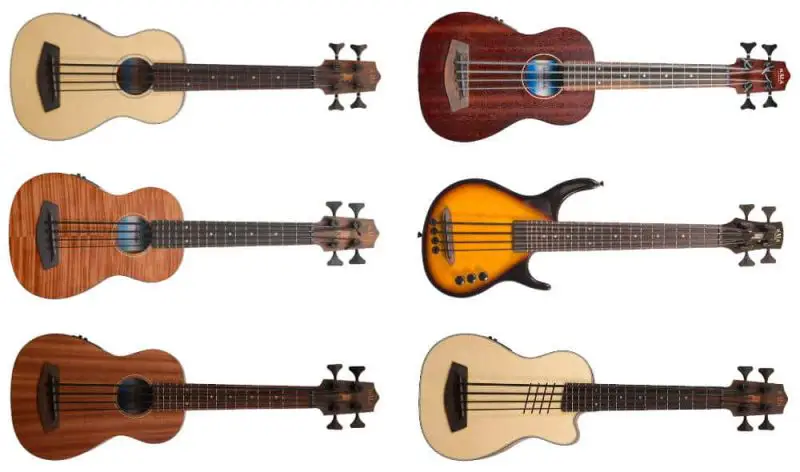
A bass ukulele is simply a bass guitar with the body of a baritone ukulele.
The tuning of a bass ukulele is identical to a standard bass: E-A-D-G. This is also the same as the bottom four strings of a guitar.
Bass ukuleles have a much shorter scale than a standard bass. This short scale means they need thick, rubbery strings to hit the low register of a bass. This combo of a short scale and fat strings give bass ukuleles a very low string tension, so the strings feel more “floppy” than those on a regular bass guitar.
Since the low string tension produces very little volume acoustically (not plugged in) most bass ukes are designed to be played through an amp.
Despite their small size, bass ukes have a tone that is surprisingly warm and rich. Many players compare the sound of a bass ukulele to a full-size upright bass!
Recommended Bass Ukes
Kala’s U-Bass (Amazon link) is the most popular and well-known bass ukulele on the market. It’s available in a number of interesting designs, including solid body models and various tonewood configurations.
The popularity of the U-Bass has spawned a handful of imitators. Both Donner and Hadean produce a bass ukes that are well-reviewed and considerably more affordable than the U-Bass.
Acoustic-Electric Ukulele
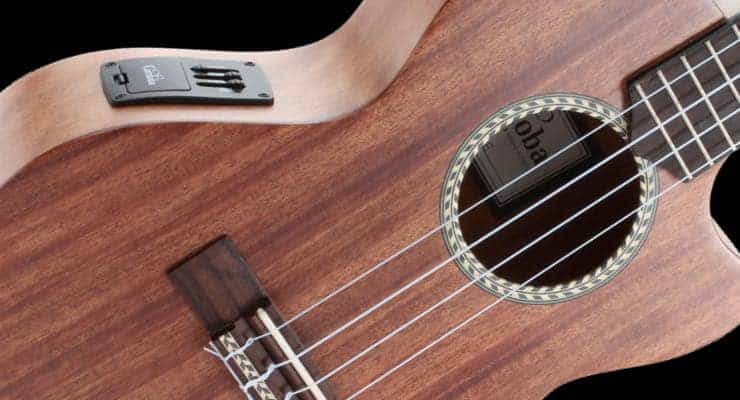
An acoustic-electric uke is simply a traditional ukulele that has been outfitted with electronics which allow the uke to be plugged into an amplifier. These electronics are known as a pickup.
Acoustic-electric ukuleles look just like standard ukes except for the input jack in the bottom of the uke and, in some cases, a panel on the side with volume and tone controls.
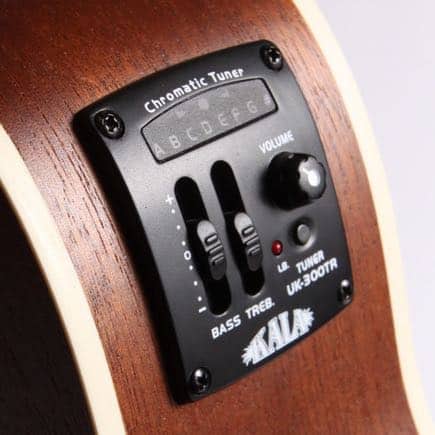
My personal opinion is that the presence of a pickup doesn’t affect the acoustic (unplugged) tone of a ukulele. All other things being equal, an acoustic-electric ukulele should sound pretty much the same as the same model without electronics.
The flexibility of these acoustic-electric models make them one of the more popular types of ukuleles.
For more information, check out our article on the best acoustic-electric ukuleles.
Recommended Acoustic-Electric Ukuleles
Electric Ukulele (Solid Body)
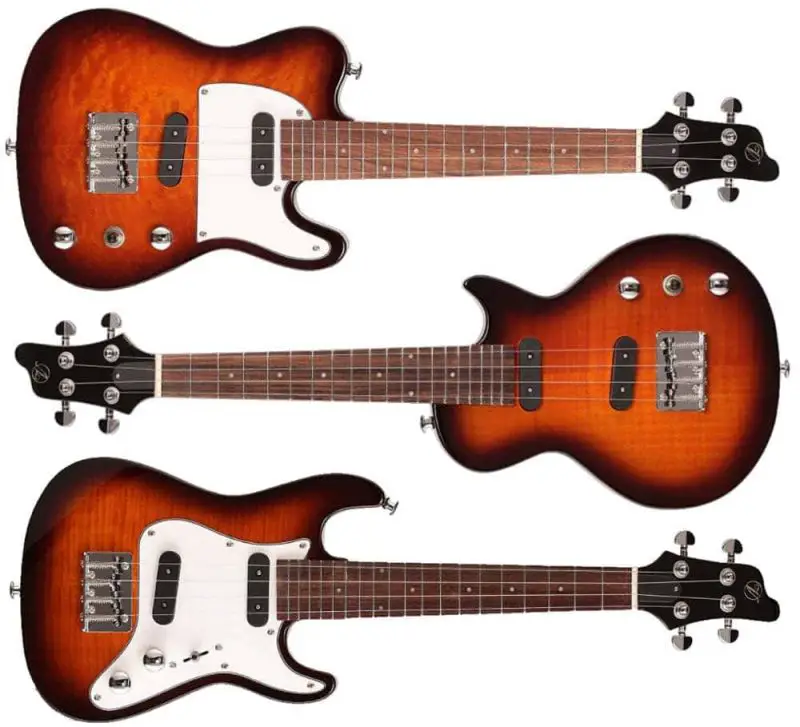
A solid body electric ukulele has a body made using a solid piece of wood rather than the open “box” found on a traditional acoustic ukulele. It is essentially a uke-sized version of the solid body electric guitars you’ve seen and heard in lots of modern music.
Like an electric guitar, an electric ukulele barely produces any sound unless it’s plugged into an amplifier. A decent starter ukulele amp will run $50 to $100, so be sure you’re factoring this into your budget.
Some electric ukes have nylon strings while others have steel strings. The tone of the steel string models will be closer to a full-size electric guitar.
Electric ukes have an undeniable “cool factor,” but they are a bit of a novelty and might make a better second (or third) uke than a primary instrument.
Recommended Electric Ukes
Pictured at the beginning of this section, Vorson builds some of the more popular solid body electric ukes. They produce models based on classic electric guitar designs, including the Gibson Les Paul and Fender’s famous Telecaster and Strat body styles. AC/DC fans might want to consider Aileen’s slick SG copy…
Resonator Ukulele
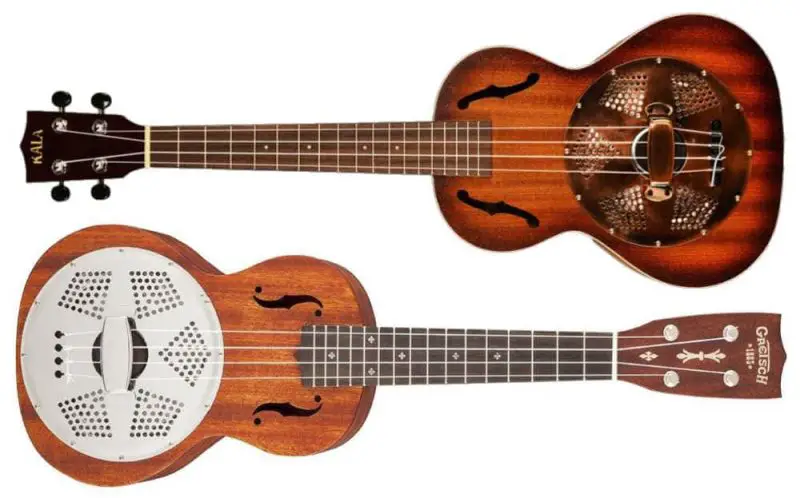
A resonator ukulele is a scaled-down version of the resonator guitar, which is a popular guitar choice for blues and slide players. Other names include resophonic ukuleles or reso ukes.
Resonator ukes are tuned to a standard uke tuning (G-C-E-A) and are played like any other ukulele. The primary difference is in the look and tone.
Resonator ukes have a metal cone built into the body that helps produce a louder, brighter, more “twangy” tone than a standard uke. Like the banjo ukulele, resonator ukes were developed around the 1920s to offer players a ukulele with more volume and projection.
Resonator ukuleles are available with a wooden body and a metal body. The wood version is a bit warmer and mellower while the metal version is brighter and louder.
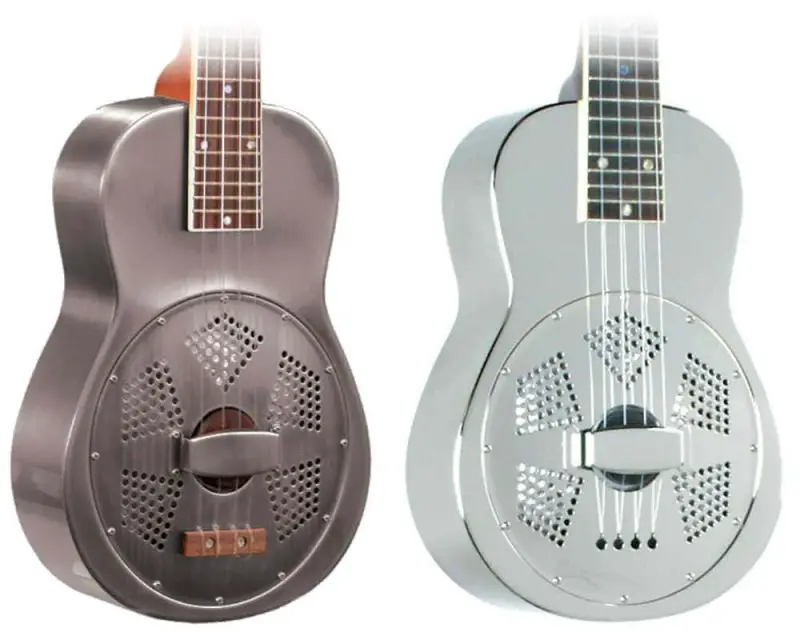
Recommended Resonator Ukes
The Gretsch G9112 is probably the most budget-friendly resonator uke around, but all of the ukes pictured above are respectable entry-level resonator ukes. However, “entry-level” is a subjective term since they start at around $250 and get up around $500 for the metal body versions.
- The Gretsch G9112 Resonator ukulele packs a powerful punch with it’s 6” “Biscuit” resonator cone! If you are tired of not being heard, cry no more, this concert size uke is guaranteed to cut through any mix. Prominent features include a rosewood biscuit bridge, mahogany top, back and sides. A one piece mahogany neck with a bone nut. You will fly across the 16 fret, rosewood fingerboard with ease and stay in perfect tune with the Grover Sta-Tite tuning pegs. With the beautiful “open
- Features
- “Open pore” Semi-gloss finish
If budget isn’t an issue, you may want to consider check out high-end builders like Beltona and Phillips.
Archtop Ukulele
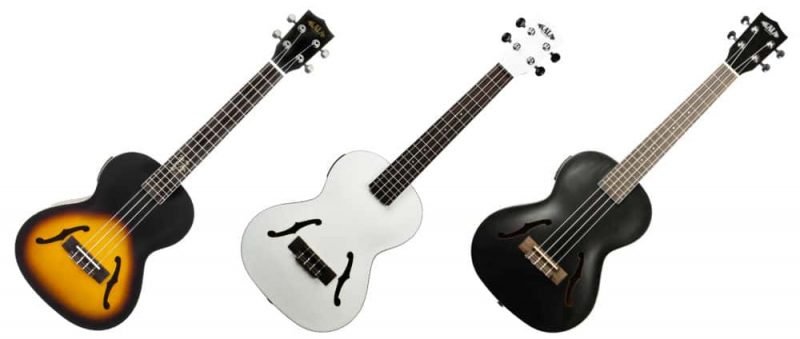
An archtop ukulele is the uke version of an archtop guitar. They’re tuned and played like a standard ukulele (G-C-E-A) with the only difference being the appearance of the instrument.
Archtop guitars are popular among jazz players for their rich, mellow tone, but these qualities don’t really translate over to the small ukulele body. The archtop ukes I’ve played and heard over the years have all sounded more or less like a regular non-archtop uke.
Recommended Archtop Ukuleles
As far as I know, Kala is the only major manufacturer currently offering an archtop uke as part of their regular lineup. Their Kala KA-JTE includes a pickup and is available in three finishes: tobacco, black, and white.
- Includes a Gig Bag!
- Spruce top
- Mahogany back and sides
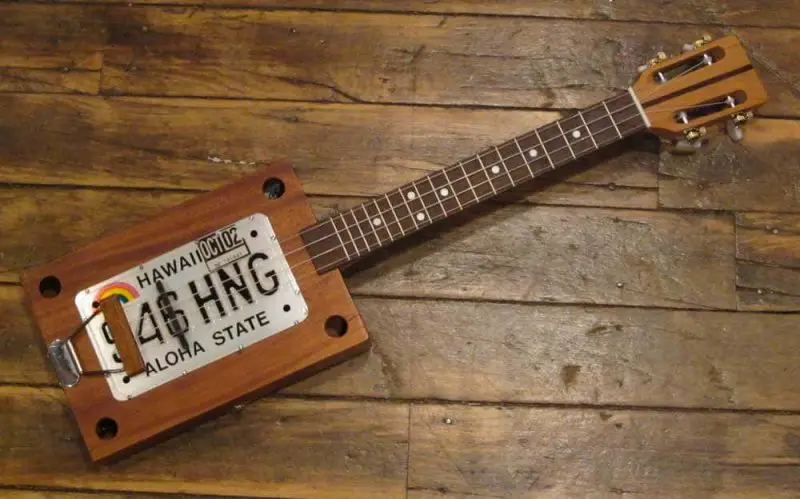 Cigar box ukulele with Hawaii license plate (via Pinterest)[/caption]
Cigar box ukulele with Hawaii license plate (via Pinterest)[/caption]
As the name implies, a cigar box uke has a wooden cigar box for the body instead of the traditional hourglass-shaped wood body.
These ukes can be purchased pre-made from large online retailers, but in my opinion the most interesting cigar box ukes are found on sites like Etsy and eBay. Of course, many folks simply choose to make their own.
[adinserter block=”8″]
Other Types of Ukuleles?
This goal of this article was to take a look at some of the most popular types of ukuleles, but I certainly haven’t covered them all! A quick Google image search for “weird ukuleles” shows that there’s really no limit to the different ukulele varieties being made and sold around the world.
Of course, if there’s one I missed that you think should be on this list, let me know in the comments!
You Might Also Like...
-
Buying Your First Ukulele: 3 Mistakes to Avoid
A quick list of three common mistakes I see many people make when shopping for their first ukulele.
-
Ukulele Sizes: The Complete Guide to Different Uke Sizes
Confused about uke sizes? This guide explains the different ukulele sizes (soprano, concert, tenor, baritone) and discusses which sizes are best for beginners.
-
How to Buy A Ukulele: The 2024 Ukulele Buying Guide
You've decided to buy a ukulele, now what? My ukulele buying guide will help you choose a ukulele that meets your needs and budget.

